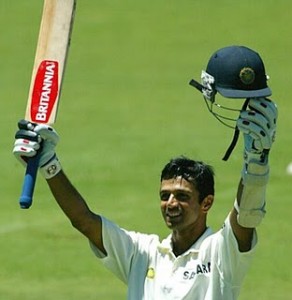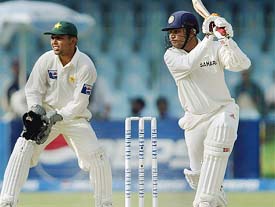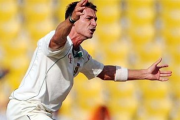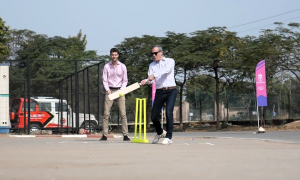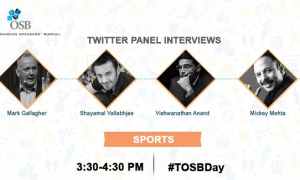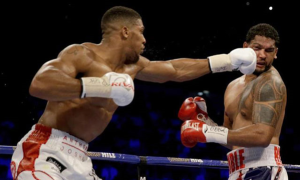Captaincy is often considered to be honey moon period immediately after assuming the post. Everything appears to fall in place and the team is largely co-operative to whatever you say. But once your tactics become predictable and your weaknesses are well known by your opponent, the going gets tougher.
The next major assignment for Team India after the 2003 World Cup came in October. The team now was capable of beating any team on a particular day, given their batting strength. Australia toured India against a full strength Indian team by that November. Ganguly had to miss out on the final and Dravid was the stand in keeper on the Eden Gardens. India did very well to restrict the Aussies to 235 for 5. The Aussies were then a bunch of confident and committed professionals who never gave up until the last ball was bowled or the last run was scored. The Indian batting presented Australia’s good bowling in an exaggerated view and lost wickets in quick succession. Australia won the game by 37 runs. Now that’s something that defined Australian cricket, bowlers eclipse the failure of their batsmen in the first half and vice-versa.
India then had the toughest challenge of the season. They had to tour Australia and play 4 test matches. The importance of a practice game is often overlooked. India though did not make the most out of it, learned to acclimatize to those conditions. The first game syndrome was again catching up with Team India, as it was on the verge of losing the test match. Ganguly’s century, Laxman’s 75 and rain ensured the Brisbane game had no result.
India continued their bad form in the second match again only before the old Kolkata pair repeated the Eden-Garden episode in Adelaide and nursed the team back to health from 85 for 4. “Rahul batted like god,” Ganguly said in the presentation. Indeed, he did! He persuaded India in doing the unbelievable – winning a test in the Australian soil!
Sehwag’s 195 was the only purple patch of the third game in Melbourne which was otherwise completely under the control of the Aussies. The final game saw the master back in form scoring his highest in test 241*. Laxman, as always scored an unnoticed 178 that forced the Aussies to switch to a defensive rather match-saving mode and play for a draw. India lost the ODI series but still had something to bring back home – the pride of winning in Australia and the Border-Gavaskar trophy.
India had to tour Pakistan in its next venture and play 3 test matches and 5 ODIs. The first two ODIs were high scoring games with both teams winning one each and the third one was completely dominated by the Pakistanis. Pakistan had the glimpse (and only a glimpse) of a series victory in the fourth but a classy Dravid and gritty Kaif kept India’s hopes of winning the series alive. Laxman’s century and Irfan Pathan’s bowling swung the match and the series India’s way. India ended up winning the series 3-2!
The first game of the test series lived the expectations as Sehwag scored a massive 308, the first triple century by an Indian. India won the first game in Multan, although it was not short of controversies as the stand-in skipper Dravid declared the innings when Sachin was batting on 194. India lost the second but won the third to seal the series 2-1. It was again a combative Dravid who stepped up when the team exactly wanted him to score his career best 270 at Rawalpindi. India didn’t have a memorable year however as it failed to impress with its performances in the rest of the season.
In 2005, Pakistan toured India for 3 test matches and 6 match ODI series. It was John Wright’s last series as a coach with Team India. India failed to capitalize on the 4 day domination that it displayed. Kamran Akmal and Razzaq ensured a draw on this occasion. Dravid’s each inning century meant India won the second match in Kolkata. Pakistan leveled the series by winning the third.
Ganguly’s batting then had come under severe criticism as the ruthless media and crowd tore him apart with ‘Maggi’ jokes. Mahendra Singh Dhoni was the find of the ODI series as he made a mammoth 148 at Vishakapattinam. India lost the series 2-4 as it had to miss out all the key players due to injury concerns.
Greg Chappell was the preferred coach, as India claimed to have better understanding with foreign coaches. It didn’t take much time to prove all those claims wrong as Chappell had asked Ganguly to step down from captaincy. The spat continued for another 3 months which eventually saw Ganguly forced out of the Indian team for his poor run with the bat. The media had obviously got a news that can hogg the headlines for a week – may be even a month!
India’s Mr. Dependable Rahul Dravid had a dream run scoring copious amount – 23% of the total runs scored under Ganguly. He won two awards as the ‘ICC test player of the year’ and ‘ICC Player of the year’ for the year 2004. A part of Ganguly’s strategy was to play a team combination that read 7-4. This meant a selfless Dravid had to keep wickets until a new genuine wicket keeper batsman is found, and he did. He was the best batsman of the lustrum for India. The commitment and consistency-driven batsman was undisputedly declared the best No. 3 batsman.
Following the controversies, Dravid was considered as the captaincy material and was asked to lead the team. India ground Sri Lanka 6-1 at home which ensured a fantastic start to Dravid’s captaincy. This also meant Ganguly’s career was riding into sunset. Greg Chappell – the man whom Ganguly thoroughly believed had betrayed him then. Kiran Moore who was no fan of Dada welcomed Greg’s first important move on the chess board with a smile. Of course it was just his first move; there were still a lot more coins on the board for him to negotiate.
(Contd. Next Friday…)
Tags: Captaincy, Captian, Cricket, ICC Cricket World Cup, India, Rahul Dravid, Saurav Ganguly, Sports, Virender Sehwag, World Cup

